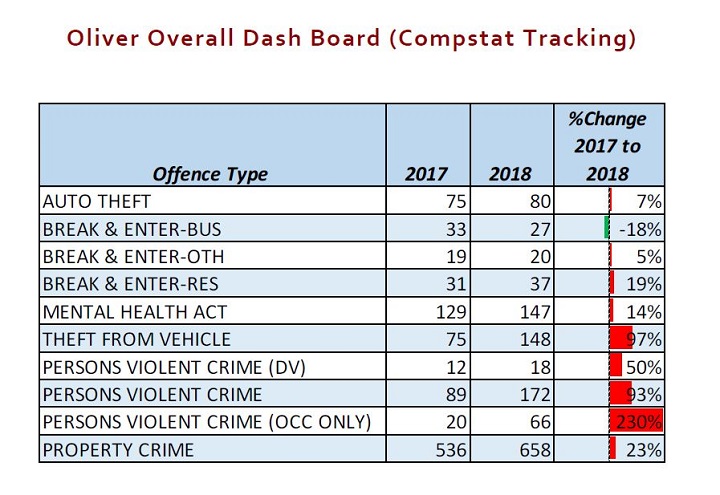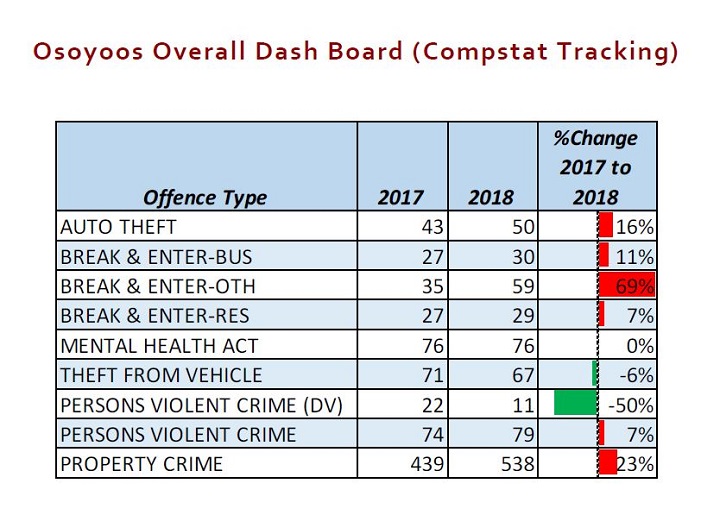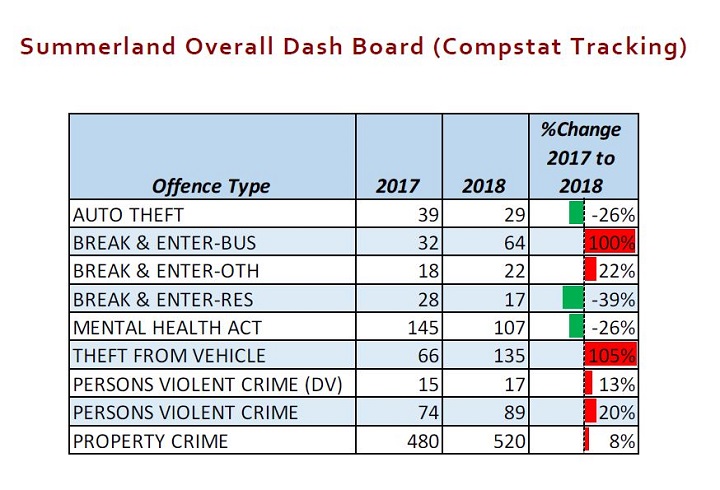The new mayor of Oliver, B.C., says his small town has a big crime problem.

Last week, the RCMP’s Penticton South Okanagan Similkameen Regional Detachment released its statistical report for 2018 — and the numbers for Oliver, which has an approximate population of 5,000, are surprising.
The stats show a 97 per cent rise in thefts from vehicles, with 148 incidents in 2018 up from 75 in 2017. There was also a 93 per cent increase in violent crime, which rose from 89 cases last year to 172 this year, and a massive 230 per cent increase in violent crime at the Okanagan Correctional Centre near Oliver, with the number of cases soaring from 20 to 66.
“Yes,” Oliver Mayor Martin Johansen replied when asked if his town has a crime problem. “Yes. Full stop. Yes, it does.”
When compared to other small South Okanagan communities, such as Osoyoos (pop.: 5,000) and Summerland (pop.: 11,000), Oliver’s numbers overshadowed its neighbours.
“It’s completely unacceptable. And the public has had enough of it as well,” Johansen said of the statistics on Tuesday. “In response to those increases in calls and crime, we have established a public safety and a crime prevention advisory committee.”
“I’d like to see improvement in public safety, but one of the other things I’d like the committee do is come up with some initiatives that are going to complement and enhance the effectiveness of policing in the area,” the mayor added.
Johansen said policing resources are stretched thin.
Police stats show Oliver had more auto thefts (80) than Osoyoos (50) or Summerland (29) in 2018. This was also the same for:

Get daily National news
- Mental Health Act incidents (Oliver, 147; Osoyoos, 76; Summerland, 107)
- Property crime (Oliver, 659; Osoyoos, 538; Summerland, 520)
- Calls for service (Oliver, 4,530; Osoyoos, 3,070; Summerland, 3026)
“We need to do something about it,” Johansen said. “It is unacceptable that Oliver stands out amongst all the other communities. Our calls for service in the 4,500 range is 1,500 higher than Osoyoos.
The mayor is asking if there’s a correlation between the correctional centre and the rise in crime within town boundaries.
Notably, the Ministry of Public Safety says inmates arrived in a phase-in approach in early 2017, therefore a higher inmate ratio in 2018 resulted in more incidents within the correctional centre.
According to the province, most inmates return to their home communities upon release, and that all inmates are provided with the means necessary to return home, or to another location that is considered reasonable or necessary.
“That’s one of the things I’d like to understand a lot more: what’s the impact this correctional centre has had on the town of Oliver and the surrounding area?” said Johansen.
Johansen said a community can’t arrest its way out of this issue so hiring 50 more police officers, for example, isn’t going to solve the problem, though an increase in cops would help.
“We have some social issues, we have some economic issues that we need to deal with,” he said. “We need to get people connected with the services that can help them. It’s a vicious cycle, and if we don’t break that cycle without helping these people, it’s just going to continue.”
Johansen also suspects these crimes are being committed by a combination of criminals from Oliver and people passing through, but he doesn’t have concrete facts. However, he’s hoping the committee will get that information and make sure the public gets that information as well.
“There is a lot of information out there,” he said. “Not all of it is true. Let’s get the facts to everybody so that we can do something positive.”









Comments